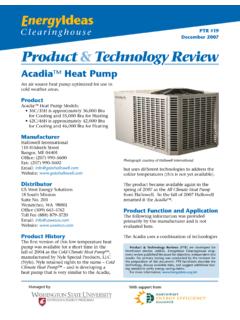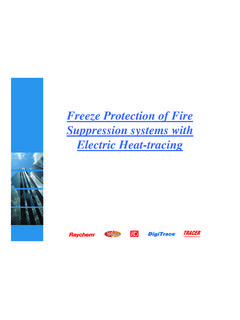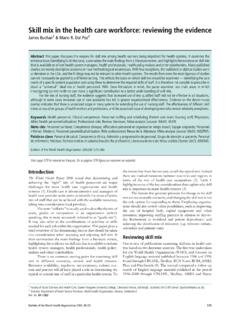Transcription of FAN WALL Technology™ Product & Technology Review
1 Product & Technology ReviewFAN WALL Technology Page 1 FAN WALL Technology This is a fan-array approach to air handler design that provides design flexibility, reduced maintenance costs, and energy FAN WALL Technology Manufacturer Huntair, Myslony , OR 97062 Phone: 503-639-0113 Fax: 503-639-1269 Website: Contact in the Northwest Northwest Sales Manager: Kevin NolanEmail: Sales Manager: Mike PostEmail: Other contact information for both of these distributors is the same as the Debut in the 2003 Product Function and Application According to the ManufacturerFAN WALL Technology is Huntair s name for a new way of assembling custom air handling units using an array of smaller fans to replace a traditional single large fan. This reduces the footprint of the air handler, allows design flexibility, simplifies maintenance, reduces low-frequency noise (rumble) within the air handler, and usually saves energy, for little or no increase in first costs.
2 These air handlers are a niche Product used for special applications with stringent requirements for unit size, reliability and noise FAN WALL Technology is a new approach to air handler design using an array of smaller fans to replace a traditional single large fan. Product & Technology ReviewFAN WALL Technology Page 2 Product & Technology ReviewFAN WALL Technology Page 3generation. Typical applications include sports stadiums, semiconductor fabrication facilities and concert custom air handling units they supply using this Technology incorporate multiple direct-drive centrifugal plenum fans, assembled in a rectangular array of four to 300+ fans, all discharging into a single plenum. The fans used are specially designed and optimized for use in FAN WALL arrays. Each fan array is usually controlled by a single variable speed drive, which controls the speed of all fans simultaneously. The use of multiple direct-drive fans operating in parallel improves reliability by providing redundancy.
3 Optimized fan wheel construction and improved internal aerodynamics further enhance energy performance. FAN WALL Technology adds an additional control dimension that can significantly reduce energy consumption on highly diversified variable air volume (VAV) systems. In traditional systems, air handlers are designed and specified to perform at a maximum duty point in terms of pressure and air flow, and in most cases the design engineer includes a safety margin in the design. This, coupled with an allowance for highly variable pressure drops due to filter loading over time, will usually result in an installed fan that is very different from what was calculated to meet only the system air-flow requirements. In a traditional system using direct drive motors, it is common to see motor loads at 1/4th to 1/8th of their nameplate rating for a significant portion of their operation hours, resulting in reduced power factors and lower fan and motor efficiencies.
4 To more closely match site conditions, the FAN WALL array can be tuned by turning one or more fans off to allow remaining fans and motors to be fully loaded at or near peak efficiency. Air flow rates can be varied through use of a variable speed drive, byturning fans on and off, or by using both controlstrategies in combination. The FAN WALL Technology inherently reduces low frequency noise generation, due to the higher tip speed of the smaller diameter fans and their lower mass, which reduces rumble . Additional fan noise reduction is obtained by incorporating coplanar silencers sound-absorbing enclosures built around the four sides of each of the fans in the array that attenuate noise in the mid and higher ranges, because they surround the fans near the source of the Savings Claims Huntair claims that using FAN WALL Technology results in air handling units that are typically 6-10 percent more energy-efficient than similar plenum fan air handlers manufactured by other manufacturers.
5 Some designs fall below this range, and some are higher. These claims are based on the effectiveness of the design features noted above to deliver energy savings through reducing total fan horsepower when compared with other plenum fan air handlers of the same capacity. By incorporating direct-drive fans, they eliminate drive losses, improving mechanical efficiency by as much as 5 percent. Additional efficiency improvements are due to optimizing the width-to-diameter ratio of the fan wheels and to improving aerodynamic performance by eliminating belt guards, large fan pedestals and much of the structure supporting the motors and belt drive mechanism. This allows air to move away from the fan unimpeded. These efficiency gains are somewhat offset by the lower efficiency of the smaller motors compared to the efficiency of the larger motor used in a single-fan air handler. Further reduction in horsepower has been measured in testing (see example in Case Studies section), and is due to the improved air flow characteristics within the plenum resulting from a design which distributes the fan inlets over the face of the plenum.
6 This reduces large pressure gradients across the inlets and outlets of the fans and thus improves the aerodynamics of air flow within the & Technology ReviewFAN WALL Technology Page 2 Product & Technology ReviewFAN WALL Technology Page 3 Additional energy savings are realized through a reduction in sound attenuation requirements, as described above under Product Function and Application. Smaller sound attenuators helps keep overall costs low, and the reduction of static pressure losses in the attenuators improves the overall efficiency of the system. The extent of energy savings due to noise reduction is usually small, and depends on the allowable low-frequency sound power levels for a given application. If the designer can reduce the attenuator length from 10ft. to 3ft., for example, they can easily save (water gauge) in static pressure loss for the system, which would save about percent in fan energy for a system operating at BenefitsProbably the greatest benefit of the FAN WALL design is the layout flexibility gained by reducing the size of the air handler footprint and the plenum fan design.
7 The reduction in footprint is possible because multiple fans of relatively small diameter are spaced across the intake, allowing much shorter inlet and discharge plenums, while maintaining good flow characteristics. Since the fan arrays can be configured in nearly any arrangement, layout flexibility is greatly enhanced. The plenum design allows duct attachment in any of five planes, which further improves layout flexibility compared to single fan systems, which are constrained by the long section of straight duct required at the outlet of a centrifugal fan or axial fan. FAN WALL air handlers can be designed to fit in a space that would be impossible for any other air handling unit. An example from the FAN WALL brochure compares two 200,000 CFM air handlers with coils and filters one using two large direct-drive plenum fans in parallel, the other using 33 plenum fans in a 3 x 11 FAN WALL array.
8 The overall dimensions of the first unit are 384 wide x 199 long x 168 high. The FAN WALL air handler measures 348 wide x 120 long x 168 high. This represents a 46 percent reduction in the unit footprint area and unit volume. The length of an air handler incorporating a FAN WALL is also independent of the aspect ratio (height vs. width). This is a tremendous advantage for air handlers that are tall and narrow or flat and smaller footprint frees up building space that can sometimes be used for more valuable functions. It could also reduce design time for the engineer if floor space is limited, since fitting a large air handler into limited space can be a time-consuming process. If the value of the floor space that is freed up by the smaller footprint is factored into the cost equation, this can make the first cost of the FAN WALL system equal to or lower than that of a conventional air handling unit, making for an immediate reduction in required external sound attenuation saves space and installation costs (in addition to energy), and reduces noise for the building occupants.
9 It also eliminates the need for expensive inertial pads and highly massive mechanical room enclosures in all but the most critical sound applications. The data summarized in Figure 1 below are based on tests performed at the Huntair testing facility (and observed by a consulting engineer hired by a customer to ensure that standard testing procedures were performed). The upper line gives the inlet sound power levels at standard octave bands measured for a New York Blower fan. The lower line shows the inlet sound power levels for the FAN WALL Technology unit. (Note: all results expressed in dB re: 10 ^-12 watts). Maintenance is simplified by the highly redundant system. The use of many identical fans allows the maintenance department to stock spare motors, bearings and other maintenance items. If one of the fans fails in operation, the variable speed drive 63 125250500 10002000 4000 8000120100806040 Octave Band (Hz)FAN WALL Air HandlerNew York BlowerPlenum FanFigure 1 Air Handler Sound Power LevelsProduct & Technology ReviewFAN WALL Technology Page 4 Product & Technology ReviewFAN WALL Technology Page 5can compensate by speeding up the remaining fans until a replacement is installed (a power or airflow sensor will send an alarm to the control system to alert maintenance personnel that the motor needs to be replaced).
10 Replacement of the smaller fans is simpler than replacement of a larger unit. The smaller motors are standard off-the-shelf sizes rather than large units that can require several weeks of lead time. In some cases, a single maintenance person can replace a fan without help, whereas a conventional large fan and motor that the array replaces may require a Testing ResultsBecause every FAN WALL is custom-designed, and because the Product is so new to the market, we did not find independent testing results. Cost FAN WALL costs are approximately $ per cubic feet per minute of air delivery including installation. This is very close to the cost of a custom air handler utilizing a conventional plenum Products and Strategies We have not been able to find other innovative approaches to air handlers that give comparable advantages to the FAN StudiesThe manufacturer provided results from several witnessed tests of FAN WALL air handlers.











